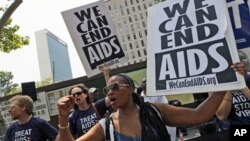The World Health Organization is issuing the first global public health guidelines aimed at reducing the spread of HIV among men who have sex with men and transgender people. The guidelines call for greater access to treatment and prevention services for HIV among these high-risk, vulnerable groups of people.
The good news is that HIV infections among heterosexual people are falling. The bad news is infection rates among homosexual men and transgender people are rising.
The World Health Organization warns the epidemic of HIV/AIDS will not end unless the spread of the disease among men who have sex with men and among transgender people and other vulnerable groups is slowed down.
WHO’s Director of HIV/AIDS Department, Gottfried Hirnschall, says men who have sex with men and transgender people have been disproportionately affected by the AIDS epidemic since it started 30 years ago, and this continues to this day.
He says there has been a recent resurgence of HIV among homosexual men, particularly in industrialized countries. But he says data show the emergence of new HIV epidemics among these men in Africa, Asia, the Caribbean, Latin America and Eastern Europe.
“The dramatic fact is that men who have sex with men are estimated to be 20 times more likely, 20 times more likely to be HIV-infected than the general populations on average. Up to 40 percent of men who have sex with men are estimated to be HIV-positive in some countries and regions…We know that transgender populations are also disproportionately affected. The rates range from 8 to 68 percent among transgender population, which is obviously unacceptable,” said Hirnschall.
The reasons behind these galloping rates are many. Many societies object to the so-called homosexual lifestyle. WHO reports more than 70 countries criminalize same-sex relationships. In some, this is punishable by death.
Dr. Hirnschall says people who engage in same gender sexual activity often are stigmatized. They suffer from discrimination, harassment and violence. This, he says, has the effect of driving such relationships underground, making people afraid to seek HIV prevention and treatment services.
He says the new WHO guidelines aim to help countries and communities scale up the services needed to reduce new infections among these vulnerable groups and save lives. He says the document contains 21 recommendations, which suggest practical ways to improve access to HIV prevention, diagnosis, treatment and care services.
“Number one, they are structural recommendations - talking, for example, about changes in law and in terms of access to services, behavioral aspects, but also bio-medical aspects - talking about testing, condom use, talking about access to treatment, talking about access to testing for other sexually transmitted infections, etc,” Hirnschall.
HIV-experts say no one individual intervention will work in stemming the epidemic. They say the guidelines have to be considered as a comprehensive package of services. They add that the greatest impact on reducing HIV-infections will be made by implementing all of the recommendations.
WHO: First Global Public Health Guidelines Issued to Reduce HIV Among Gay Men, Transgender People









